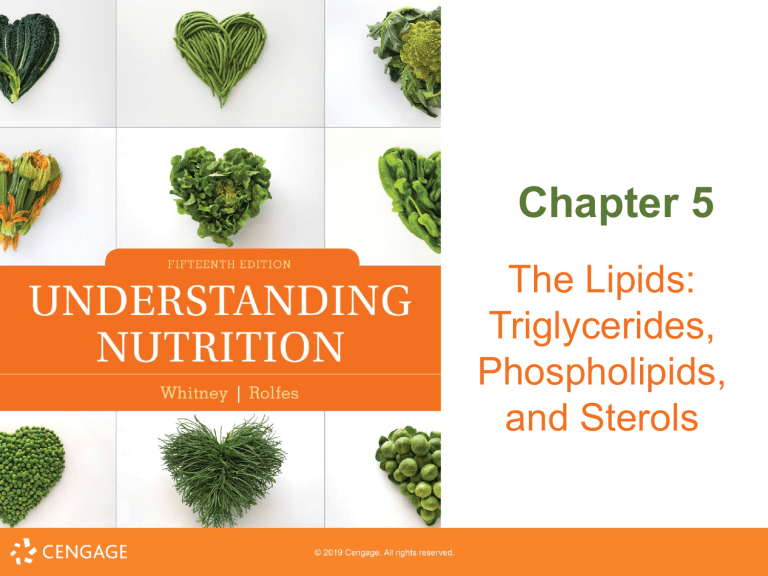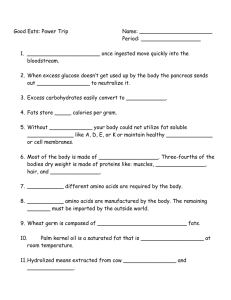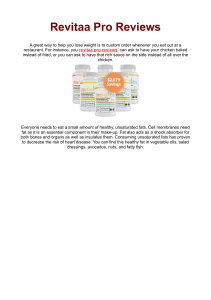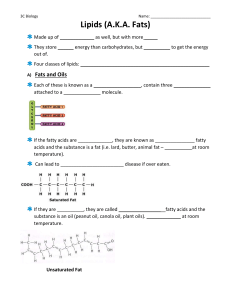
Chapter 5 The Lipids: Triglycerides, Phospholipids, and Sterols Chemist’s View of Fatty Acids and Triglycerides • Preview of lipids – Triglycerides: glycerol and three fatty acids – Fatty acids Saturated or unsaturated – Omega-3 and omega-6 fatty acids 18-carbon polyunsaturated fatty acids Fatty Acids Saturated fatty acids - Are fully loaded with hydrogens - Fully saturated with hydrogens - No double bonds Fatty Acids Unsaturated fatty acids - Has at least one double bond - Not every carbon is “saturated” with hydrogens and therefore must form a double bond. Polyunsaturated fatty acid - Has more than one double bond. 18-Carbon Fatty Acids Name Number of Carbon Atoms Number of Double Bonds Saturation Common Food Sources Stearic acid 18 0 Saturated Most animal fats Oleic acid 18 1 Monounsaturated Olive and canola oils Linoleic acid 18 2 Polyunsaturated Sunflower, safflower, corn, and soybean oils Linolenic acid 18 3 Polyunsaturated Soybean and canola oils, flaxseed, walnuts NOTE: Chemists use a shorthand notation to describe fatty acids. The first number indicates the number of carbon atoms; the second, the number of the double bonds. For example, the notation for stearic acid is 18:0. Characteristics of Solid Fats and Oils Which fatty acids tend to be solid at room temperature? a) Unsaturated b) Saturated Answer: b Explanation: Saturated fats tend to be solid because their tails are straight and they “stack” well, for example, butter. Fats with a double bond have “kinked” chains, they don’t “stack,” therefore form liquids, for example, oil. Fats spoil (go rancid) when exposed to oxygen. Polyunsaturated fats spoil most readily. Heat and light exposure speed up rancidity. Diagram of Saturated and Unsaturated Fatty Acids Compared Fatty Acid Composition of Common Food Fats Hydrogenation • Hydrogenation – Protects against oxidation – prolonging shelf life – Alters the texture of food • Trans-Fatty Acids – Act like a saturated fat in the body – Heart disease connection being researched Degree of Unsaturation • Saturated fat is more resistant to oxidation – Oxidation = substance combines with oxygen and losses an electron • Monounsaturated fat is slightly less susceptible to spoilage • Polyunsaturated fat spoils most readily • Protection from rancidity – Seal in airtight containers away from light – Add antioxidants – Hydrogenation Phospholipids • Solubility in fat and water • Emulsifiers in food industry • Lecithin is best-known – Found in eggs, liver, soybeans, wheat germ, and peanuts • Food sources – Seafood, eggs, seed oils and meat. • Roles – Part of cell membranes – Emulsifiers Sterols • Food sources – Cholesterol – Plant sterols • Roles of sterols – Made in the body – Structural component of cell membranes – Liver produces 8001500mg cholesterol per day Lipid Digestion • Fats are hydrophobic – Digestive enzymes are hydrophilic • Goal of fat digestion – Dismantle triglycerides Monoglycerides, fatty acids, and glycerol Fat Digestion in the GI Tract The Beginning of Fat Digestion • Mouth – Lingual lipase plays role in fat digestion in infants • Stomach – Strong muscle contractions – Gastric lipase – Little fat digestion Lipid Digestion in the Small Intestine • Cholecystokinin (CCK) – Gallbladder releases bile – Bile acts as emulsifier • Pancreatic lipase • Hydrolysis – Triglycerides and phospholipids • Bile routes – Effect on blood cholesterol levels Emulsification of Fat by Bile • How An Emulsifier Works – Lipids are hydrophobic – Separate from watery fluids of digestion – Digestive enzymes are hydrophilic – Bile from the liver emulsifies lipids – Enzymes are then able to break down lipids to monoglycerides and fatty acids Enterohepatic Circulation 2 Answer: 1. Liver 2. Bile 3. Small 4. Colon 1 3 4 Lipoproteins • Lipoproteins – LDL (Low Density Lipoproteins) “Bad” • Composed primarily of cholesterol • Transport lipids to the tissues • High LDL is associated w/ higher risk of heart attack – HDL (High Density Lipoproteins) “Good” • Composed primarily of protein • Transport cholesterol from the cells to the liver • Seems to have a protective effect Lipoproteins • Health Implications – High LDL – associated with higher risk of heart attack – High HDL – has a protective effect – Factors that lower LDL and raise HDL – – – – – – Weight Control Replace Sat Fat with Mono- & PolyUnsaturated fat Soluble Fibers Phytochemicals Moderate alcohol consumption Physical activity Sizes and Compositions of the Lipoproteins Roles of Triglycerides • Provide the cells with energy – Virtually unlimited ability to store fat energy • Adipose tissue stores body fat – Secretes hormones (adipokines) • Other uses of fat in the body – – – – Skin insulation Shock absorption Cell membrane material Cell signaling pathways An Adipose Cell Omega-6 and Omega-3 Fatty Acids • Linoleic acid—Omega-6 fatty acid – Essential fatty acid Can make other omega-6 fatty acids – Sources: vegetable oils and meats • Linolenic acid—Omega-3 fatty acid – Essential fatty acid Must be supplied by food – DHA – EPA Eicosanoids • Eicosanoids – “Hormonelike” – Health benefits • Omega-6 to Omega-3 ratio • Fatty acid deficiencies – Rare in the United States – Symptoms A Preview of Lipid Metabolism 1. _______ cells store fat after meals. 2. Lipoprotein lipase ________ triglycerides. 3. Fat supplies ___ percent of energy needs during rest. 4. During times of energy deprivation, fat and lean ________ tissue are used for energy. Answer: 1. Adipose 2. Hydrolyzes 3. 60 4. Protein Health Effects of Saturated Fats, Trans Fats, and Cholesterol • • • • Focus on quality and quantity Current US diet contains excessive solid fats Blood lipid profile Heart disease – Elevated LDL cholesterol a risk factor Saturated fats increase LDL cholesterol o Promote blood clotting Ways to lower dietary saturated fat Trans fats increase LDL and lower HDL cholesterol Dietary cholesterol Fat Links to Cancer and Obesity • Cancer – Promotion rather than initiation of cancer – Dietary fat and cancer risk Differs for various types of cancer • Obesity – Cutting fat from diet often reduce kcalories – Dietary recommendations Recommended Intakes of Saturated Fat, Trans Fat, and Cholesterol • DRI and Dietary Guidelines – 20 to 35 percent of daily energy from fat Less than 10 percent from saturated fat As little trans fat as possible – No longer limit to <300 mg cholesterol – Average US consumption of fat • Avoid getting too little fat – Recommendation: one teaspoon of fat at meals Health Effects of Monounsaturated and Polyunsaturated Fats 1. Replacing ________ fats with __________ fats helps reduce risk of heart disease. 2. Regular consumption of omega-__ fatty acids suppresses ___________, which may protect against some cancers. Answer: 1. Saturated, unsaturated 2. 3; inflammation Explanation: Fish oil supplements are available but not recommended for routine supplementation due to side effects. Replacing Saturated Fat with Unsaturated Fat Portion sizes have been adjusted so that each of these foods provides approximately 100 kcalories. Notice that for a similar number of kcalories and grams of fat, the second choices offer less saturated fat and more unsaturated fat. …with these foods. Replace these foods… Saturated Fat (g) Unsaturated Fat (g) Total Fat (g) Olive oil (1 tbs) 2 9 11 Sunflower seeds (2 tbs) 1 7 8 Mixed nuts (2 tbs) 1 8 9 Avocado (6 slices) 2 8 10 5 Salmon (2 oz) 1 3 4 40 Totals 7 35 42 Saturated Fat (g) Unsaturat ed Fat (g) Total Fat (g) Butter (1 tbs) 7 4 11 Bacon (2 slices) 3 6 9 Potato chips (10 chips) 2 5 7 Cheese (1 slice) 4 4 8 Steak (1'/2 0z) 2 3 Totals 18 22 Recommended Intakes of Monoand Polyunsaturated Fats • 20 to 35 percent of kcalories from fat – Includes essential fatty acids Established AI • DRI – Linoleic acid: 5–10 percent of daily energy – Linolenic acid: 0.6–1.2 percent of daily energy No DRI for EPA and DHA Selecting Groceries • Fat-soluble vitamins – A, D, E, and K • Flavor, texture, and palatability • Protein foods – Best choices • Milk and milk products – Best choices Cutting Fat Cuts kCalories and Saturated Fat Grocery Choices • Vegetables, fruits, and grains – Lowers consumption of fats Fats from avocado and olive benefits Provides vitamins, fiber, phytochemicals – Caution on refined grain products • Solid fats and oils – Source of fat—discretionary or not Food Labeling • • • • Read food labels Total fat, saturated fat, trans fat, cholesterol Compare products Percent Daily Value VS percent kcalories from fat (How-To 5-3) • Fat replacers – Types – Risks Nutrient absorption Highlight 5 High-Fat Foods—Friend or Foe? Guidelines for Fat Intake • Lower saturated and trans fat – Moderate kcalories – Enough fats for good health – Not too much of the harmful fats – Consumer education on types of fat • DRI recommendations – Compatible with low rates of disease High-Fat Foods and Heart Health • Olive oil – Benefits for heart health – Replace saturated fats • Nuts – Fat composition – Benefits for heart health Blood pressure, LDL, inflammation – Cautious advice for dietary inclusion Fish • Omega-3 fatty acids – Benefits for heart health Benefits for hypertension or atherosclerosis – Dietary recommendations • Environmental contaminants – Mercury High-Fat Foods and Heart Disease • Saturated fat main determinant of LDL cholesterol – Sources of saturated fat in the United States Meats Whole milk products Tropical oils – Zero saturated fat is not possible • Trans fat – Limit hydrogenated foods Two Meals Compared The Mediterranean Diet • Features of a traditional Mediterranean diet – Low in saturated fat – Very low in trans fat – Diet composition Whole foods—vegetables, legumes, fruits Limited meat Monounsaturated and polyunsaturated fats Complex carbohydrates, fiber, and phytochemicals • Benefits for heart disease risk Mediterranean Diet Pyramid





